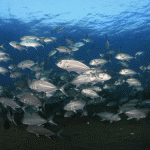
Corals first appeared on Earth 500 million years ago and are now threatened by rising sea temperatures. Image: Shutterstock
An international team is trying to save corals from rising ocean temperatures by freezing them.
Coral reef systems, such as the Great Barrier Reef, are under serious threat from global warming and rising sea temperatures. The Coral Reef Recovery Initiative, led by Dr Mary Hagedorn of the Smithsonian Institute Washington DC and the University of Hawaii Institute of Marine Biology, are looking at using cryogenics to preserve tissue samples harvested from these reefs.
One of the risks of freezing the samples is that ice crystals are spiky and can damage cell walls. The coral cells are steeped in the chemical cocktail of cryo-protectants, devised by Professor Douglas MacFarlane from Monash University and a member of The Coral Reef Recovery Initiative. These will minimise ice crystal formation and protect then cell walls from what he describes as “challenging events that are about to happen to it.”
The coral is then quenched in liquid nitrogen and stored below -120Ëš celsius. At these temperatures, the chemical matrix turns into a hard glassy substance, halting the cell’s biochemistry. Professor MacFarlane says “(there are) quite a number of materials that are stored that way these days, including sperm.”
Months, years or even decades down the track, the samples will be warmed up and grown in coral nurseries. The scientists can also split off spikes from these new corals and use them to propagate another colony. These can then be placed back out on the reef, to replant and re-establish areas that have been damaged by storms or rising sea temperatures.
Professor Macfarlane says the Great Barrier Reef is not only affected by rising sea temperatures, but also by our El Nino summers, when the waters off the east coast of Australia are warm. “Corals don’t like big variations in temperature.”
Corals contain small organisms called zooxanthellae- small photosynthetic animals that live inside the corals and produce food in return for shelter. For reasons that aren’t very well known, the corals will “˜spit out’ these organisms at high temperatures and then begin to starve.
The corals can recover their zooxanthellae if the temperatures drop, but this has to occur within a short period of time i.e. a week or so, otherwise they will bleach and die. And an El Nino summer means higher temperatures over several months.
Another problem faced by the coral is increasing levels of carbon dioxide in the atmosphere and the oceans, causing it to become more acidic. Animals with calcium carbonate exoskeletons, such as corals, are particularly affected as the increasing acidification their ability to produce these structures.






